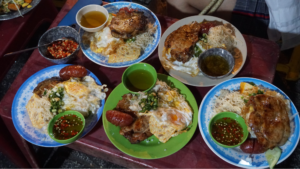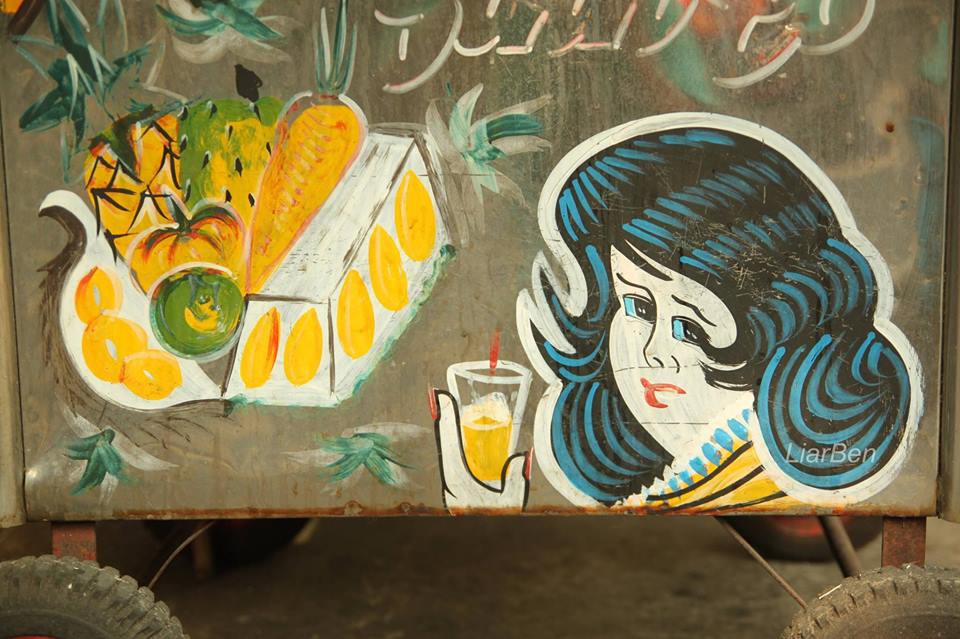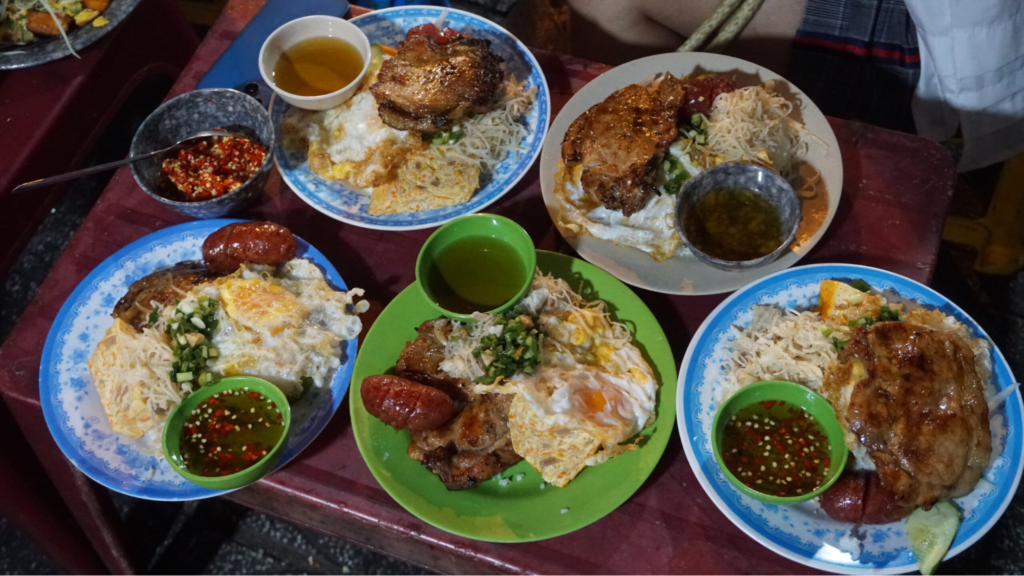The Hidden Gems of Vietnamese Street Food
Bò bía ngọt, kẹo chỉ/kẹo tơ hồng), kẹo kéo (Dragon beard candy, sweet popiah candy, Vietnamese taffy candy)
The carts with the words “Dragon beard candy, sweet popiah candy, Vietnamese taffy candy” written in white chalk roaming the alleys with their cries echoing around the street corners have been deeply imprinted in the subconscious of many generations.
Imagine taking a bite of sweet spring rolls, the soft rice paper layer revealing the sweet filling of malt and shredded coconut. Each bite brings me back to sunny afternoons playing hopscotch with my neighbors with crisp laughter.
Not too far from the sophistication, the candy is made by taking a small piece from a large block of malt; after each hand movement, continuously roll the candy twice, shake it vigorously so that the tapioca starch just dipped falls onto the tray. Through the skillful hands of the craftsman, the sugar block immediately “transforms” into thousands of thin strands. The rolled candy is placed on spongy rice paper, covered with a little coconut, roasted peanuts and a few drops of condensed milk on the surface. Enjoy it right after it is done to feel the crispness of the spongy cake. Pure white, chewy and fragrant taste of sugar and crispy shredded coconut. The simple tools to grate coconut are beer can lids, along with pieces of cake made from dried tapioca flour.
As for taffy, the list only includes sugar, vanilla powder and water, add a little peanuts as filling, and that’s enough. The way to make taffy is actually very simple. Add sugar, vanilla powder, pour in a little water to cover and boil over medium heat until the sugar thickens. Dip the tip of a chopstick into the solution and drop it into a bowl of water, if it doesn’t dissolve, it meets the requirements for taffy. After that, people pour the sugar onto a piece of plastic coated with non-stick oil. Wait for the sugar to cool down, then stretch it out with your hands and fold it, knead it until the sugar is really soft and white.
It’s that simple, but the sweet candy on the street cart has entered the childhood memories of many people, so finding it today is like accidentally finding a hidden treasure in the middle of a bustling city.
Kẹo mạch nha (Malt Candy)
Kẹo mạch nha is a traditional Vietnamese candy made from malt syrup and sugar. It has a rich, caramel-like flavor and a slightly sticky texture that makes it enjoyable to eat. Usually shaped into small squares or fun figures, this chewy treat is crafted using time-honored methods, making it a popular snack that reflects the simplicity and charm of Vietnamese sweets.
Bánh ống (Rolled Wafer)
Bánh ống are hollow, tube-shaped cakes resembling water pipes, typically cut into even pieces based on personal preference. They are best enjoyed fresh from the cart, while still hot, with an aroma that’s unforgettable. At this moment, the cakes are crispy and create a satisfying crunch when bitten into, making them incredibly appealing. On cold days, holding a warm bag of bánh ống while watching a show or chatting with friends is a perfect treat.
Bánh đa kê (Millet Cake)
Bánh đa kê is a traditional Vietnamese snack made from roasted rice crackers topped with a mix of ingredients like mung bean paste, peanuts, and spices. It offers a satisfying crunch and a balanced flavor profile, combining sweetness with a hint of savory. Often enjoyed as a street food staple, bánh đa kê is both simple and delicious, making it a popular choice for those looking for a quick bite or a flavorful snack on the go.
Bánh tai yến (Bird’s nest cake)
Bird’s nest cake, also known as cone cake, looks like a bird’s nest and is commonly sold on sidewalks and street corners. This is a familiar snack of the 6x and 7x generations. Bird’s nest cake is made from the main ingredients of rice flour, glutinous rice flour, coconut milk, sugar, and vanilla. One of the most important steps in making bird’s nest cake is kneading and beating the dough. The dough must be kneaded into a thick mixture by the maker and beaten until it becomes thick. This step, which requires patience, ingenuity, and meticulousness, is done by hand instead of a machine because beating the dough by hand will control the mixture, making the batch delicious and correct.
Pro Tips: Where to Get Lucky and Find These Delights
To increase your chances of discovering these nostalgic treats, explore local markets and street food stalls, especially during festivals and cultural events. Keep an ear out for vendors calling out their specialties, and don’t hesitate to ask locals for recommendations. The thrill of the hunt is part of the adventure—embrace it!
These little treats are not just food; they are a gateway to the flavors of childhood and the rich tapestry of Vietnamese street culture. While they may be rare, the joy of stumbling upon them is well worth the effort. So, take a stroll through the streets, indulge your senses, and experience the magic of these hidden gems!
CHOOSE HUM FOR AN AUTHENTIC VIETNAMESE EXPERIENCE
Uncover the true Vietnam on a 12-day, 11-night adventure. From the ancient cities of the North to the cultural heartland of the Central region and the vibrant South, we’ll take you off the beaten path to meet locals, experience authentic traditions, and create lasting memories.
To truly experience Vietnam on a deeper level, stay with Hum.

















